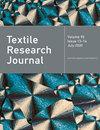基于多头关注机制的纤维识别框架
IF 1.9
4区 工程技术
Q2 MATERIALS SCIENCE, TEXTILES
引用次数: 0
摘要
卷积神经网络在纺织纤维识别领域得到了广泛的研究。然而,卷积层和池化层对提取的特征进行下采样会导致细粒度纤维特征的大量丢失。为解决这一问题,我们提出了一种用于纤维识别的多头注意力框架。首先,使用光学放大镜和智能手机等智能设备捕捉纺织品表面图像。其次,通过多头自注意力分别学习纤维特征和标签嵌入。最后,利用标签嵌入来查询纤维类型的存在,并在多头交叉注意模块中汇集与类型相关的特征来对纤维进行分类。实验结果表明,所提出的方法在纺织品表面图像数据集上表现优异,与基于卷积神经网络的纤维识别方法 Cu-Net 相比,平均精度提高了 6%,与结合了卷积神经网络和注意力机制的纤维识别方法 FiberCT 相比,平均精度提高了 5%。值得一提的是,在所收集的数据集中,以 200 倍放大率拍摄的纤维图像最有利于模型识别纤维。所提出的方法在 200 倍放大率的图像上实现了平均精度 80.2% 的纤维识别准确率。本文章由计算机程序翻译,如有差异,请以英文原文为准。
A fiber recognition framework based on multi-head attention mechanism
Convolutional neural networks have been extensively studied in textile fiber recognition. However, the down-sampling performed by the convolutional and pooling layers on the extracted features result in a significant loss of fine-grained fiber features. To address this issue, a multi-head attention framework for fiber recognition has been proposed. First, textile surface images are captured using optical magnifiers and smart devices such as smartphones. Second, fiber features and label embeddings are learned separately by multi-head self-attention. Finally, the label embeddings are used to query the presence of fiber types, and pool type-related features in the multi-head cross-attention module to classify fibers. The experimental results demonstrate that the proposed method performs exceptionally well on the textile surface image dataset, with a mean average precision accuracy improvement of 6% compared with the convolutional neural network-based fiber recognition method Cu-Net, and a 5% improvement compared with the fiber recognition method FiberCT combining convolutional neural networks and attention mechanisms. It is worth mentioning that the fiber images captured at 200× magnification in the collected dataset are most favorable for models to recognize fiber. The proposed method achieves a mean average precision fiber recognition accuracy of 80.2% on images at 200× magnification.
求助全文
通过发布文献求助,成功后即可免费获取论文全文。
去求助
来源期刊

Textile Research Journal
工程技术-材料科学:纺织
CiteScore
4.00
自引率
21.70%
发文量
309
审稿时长
1.5 months
期刊介绍:
The Textile Research Journal is the leading peer reviewed Journal for textile research. It is devoted to the dissemination of fundamental, theoretical and applied scientific knowledge in materials, chemistry, manufacture and system sciences related to fibers, fibrous assemblies and textiles. The Journal serves authors and subscribers worldwide, and it is selective in accepting contributions on the basis of merit, novelty and originality.
 求助内容:
求助内容: 应助结果提醒方式:
应助结果提醒方式:


